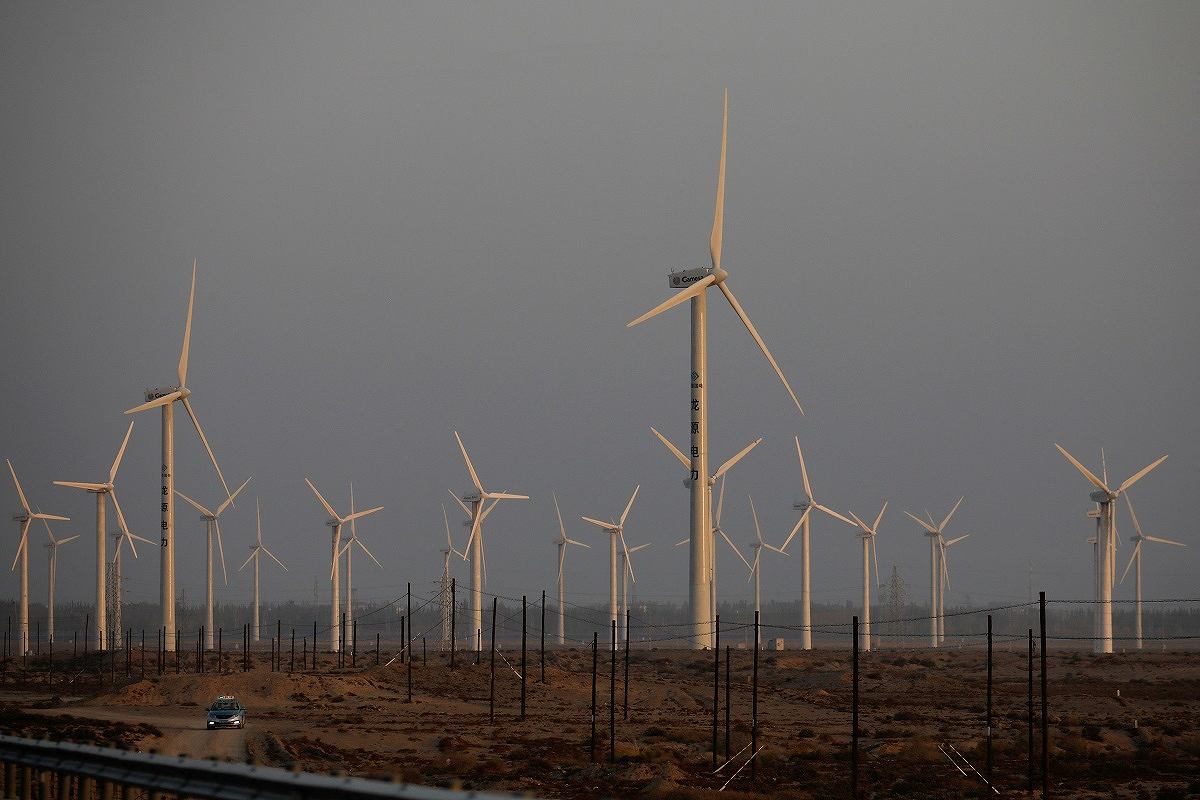
A car drives near wind turbines on a power station near Yumen, Gansu province, China September 29, 2020. Picture taken September 29, 2020.
17:50 JST, July 12, 2024
BEIJING, July 11 (Reuters) – Almost two-thirds of big wind and solar plants under construction globally are in China, where surging renewable capacity has squeezed coal’s generation share to new lows, research released on Thursday showed.
China is building 339 gigawatts (GW) of utility-scale wind and solar, or 64% of the global total, a report from U.S.-based think tank Global Energy Monitor (GEM) found. That is more than eight times the project pipeline of the second-place U.S., with 40 GW.
China’s pace puts the global goal to triple renewable capacity by the end of 2030 “well within reach” even without more hydropower, the report’s authors said, calling on China to lift its targets in climate pledges to the U.N. next year.
Beijing is also on track to meet its own 2030 goal to install 1,200 GW of wind and solar by this month – six years early – Sydney-based think tank Climate Energy Finance said last week.
Absorbing the boom in renewables remains a challenge for China’s coal-centered grid and faster development of transmission lines is needed, GEM research analyst Aiqun Yu said.
Still, the new capacity pushed renewable generation to record highs recently, according to a separate analysis published by Carbon Brief on Thursday.
China generated 53% of its electricity from coal in May, a record low, while a record 44% came from non-fossil fuel sources, indicating its carbon emissions may have peaked last year if the trend continues, according to the analysis conducted by Lauri Myllyvirta, senior fellow at Asia Society Policy Institute.
Coal’s share was down from 60% in May 2023.
Solar rose to 12% of power generation in May and wind to 11% as China added large amounts of new capacity. Hydropower at 15%, nuclear with 5% and biomass at 2% made up the rest of the non-fossil fuel power.
The increased renewable generation led carbon dioxide emissions from the power sector, which make up some 40% of China’s overall emissions, to fall 3.6% in May.
“If current rapid wind and solar deployment continues, then China’s CO2 output is likely to continue falling, making 2023 the peak year for the country’s emissions,” Myllyvirta wrote.
His analysis found solar power generation soared by a record 78% year-on-year in May to 94 terrawatt hours (TWh).
Data from China’s National Bureau of Statistics showed a 29% increase, but that excluded rooftop solar panels and therefore missed about half of the electricity from solar.
The new analysis calculated wind and solar output using power generating capacity data and utilization figures from the China Electricity Council, an industry association.
Wind power generation rose 5% on the year to 83 TWh as a 21% increase in capacity was offset by lower utilization because of variations in wind conditions. Hydropower generation rose 39% from last year, when hydropower was hit by a drought.
Gas-fired generation fell 16%, and power generation from coal fell 3.7%, even as total electricity demand increased 7.2% year-on-year.
"News Services" POPULAR ARTICLE
-

American Playwright Jeremy O. Harris Arrested in Japan on Alleged Drug Smuggling
-

Japan’s Nikkei Stock Average as JGB Yields, Yen Rise on Rate-Hike Bets
-

Japan’s Nikkei Stock Average Licks Wounds after Selloff Sparked by BOJ Hike Bets (UPDATE 1)
-

Japan’s Nikkei Stock Average Buoyed by Stable Yen; SoftBank’s Slide Caps Gains (UPDATE 1)
-

Japanese Bond Yields Zoom, Stocks Slide as Rate Hike Looms
JN ACCESS RANKING
-

Keidanren Chairman Yoshinobu Tsutsui Visits Kashiwazaki-Kariwa Nuclear Power Plant; Inspects New Emergency Safety System
-

Tokyo Economic Security Forum to Hold Inaugural Meeting Amid Tense Global Environment
-

Imports of Rare Earths from China Facing Delays, May Be Caused by Deterioration of Japan-China Relations
-

University of Tokyo Professor Discusses Japanese Economic Security in Interview Ahead of Forum
-

Japan Pulls out of Vietnam Nuclear Project, Complicating Hanoi’s Power Plans























